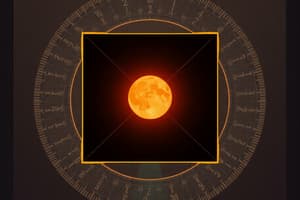Podcast
Questions and Answers
What does it mean for two segments to be congruent?
What does it mean for two segments to be congruent?
- They have different lengths.
- They have the same length. (correct)
- They are parallel.
- They intersect.
What does it mean for two angles to be congruent?
What does it mean for two angles to be congruent?
- Their measures are the same. (correct)
- Their measures are different.
- They form a straight angle.
- They are complementary.
What is an acute angle?
What is an acute angle?
An angle measuring between 0 and 90 degrees.
What is a right angle?
What is a right angle?
What is an obtuse angle?
What is an obtuse angle?
What is a straight angle?
What is a straight angle?
What defines the midpoint of a segment?
What defines the midpoint of a segment?
What is a segment bisector?
What is a segment bisector?
What is an angle bisector?
What is an angle bisector?
What are segment trisectors?
What are segment trisectors?
What are angle trisectors?
What are angle trisectors?
What does it mean for two lines, segments, or rays to be perpendicular?
What does it mean for two lines, segments, or rays to be perpendicular?
What defines complementary angles?
What defines complementary angles?
What defines supplementary angles?
What defines supplementary angles?
If two angles are right angles, then they are congruent.
If two angles are right angles, then they are congruent.
If two angles are straight angles, then they are congruent.
If two angles are straight angles, then they are congruent.
If two angles form a right angle, then they are supplementary.
If two angles form a right angle, then they are supplementary.
If two angles form a straight angle, then they are called a linear pair.
If two angles form a straight angle, then they are called a linear pair.
If two rays are collinear, have a common endpoint, and extend in opposite directions, they are called opposite rays.
If two rays are collinear, have a common endpoint, and extend in opposite directions, they are called opposite rays.
If two angles are vertical angles, then they are not congruent.
If two angles are vertical angles, then they are not congruent.
Flashcards are hidden until you start studying
Study Notes
Definitions of Angles
- Congruent Segments: Segments with equal lengths are congruent.
- Congruent Angles: Angles with the same measure are congruent.
- Acute Angle: An angle with a measure between 0 and 90 degrees.
- Right Angle: An angle with a measure of exactly 90 degrees.
- Obtuse Angle: An angle with a measure between 90 and 180 degrees.
- Straight Angle: An angle with a measure of exactly 180 degrees.
Points and Segments
- Midpoint of a Segment: A point that divides a segment into two equal parts (congruent segments).
- Segment Bisector: A line, ray, or segment that divides another segment into two congruent segments.
- Angle Bisector: A ray that divides an angle into two congruent angles.
Trisectors
- Segment Trisectors: Lines or segments that divide a segment into three equal parts (congruent segments).
- Angle Trisectors: Rays that divide an angle into three equal parts (congruent angles).
Relationships and Theorems
- Perpendicular Lines: Lines that intersect at right angles.
- Complementary Angles: Two angles whose measures sum to 90 degrees.
- Supplementary Angles: Two angles whose measures sum to 180 degrees.
- Theorem of 2 Right Angles: Both right angles are congruent.
- Theorem of 2 Straight Angles: Both straight angles are congruent.
- Theorem of Angles that form a Right Angle: Angles that combine to form a right angle are complementary.
- Theorem of Angles that form a Straight Angle: Angles that combine to form a straight angle are supplementary.
Special Angle Relationships
- Linear Pair: Two angles that form a straight angle (180 degrees).
- Opposite Rays: Two rays that are collinear, share a common endpoint, and extend in opposite directions.
- Vertical Angles: Angles formed by intersecting rays which are opposite each other, and are congruent.
- Congruent Supplements Theorem: If two angles are supplementary to the same angle (or congruent angles), then they are congruent.
Studying That Suits You
Use AI to generate personalized quizzes and flashcards to suit your learning preferences.



